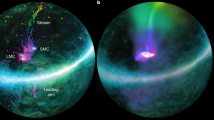Abstract
MCCREA1,2 has proposed that the encounter of the Solar System with a dense cloud of interstellar material during its passage through a spiral arm of the Galaxy may produce such climatic catastrophes on Earth as the ice epochs. His thesis, an extension of several earlier investigations3,4,5, is based on the expected effect on the solar constant of an increased accretion rate. Unfortunately, the cloud density necessary to produce the required variation is 105 to 107 cm−3, and although clouds with such extreme densities are thought to exist6, Begelman and Rees7 point out that they are so compact and unusual as to reduce the likelihood of the Sun ever encountering one. (Dennison and Mansfield's suggestion8 that there is no evidence for the existence of a nearby super-dense cloud which could have caused the most recent ice epoch has been answered by McCrea9.) Begelman and Rees7 in fact showed that a much more modest cloud density (≃102 to 103 cm−3) would prevent the solar wind from reaching the Earth, with resulting modification of the near-Earth environment; however, the climate consequences of such a modification are not well understood. We present here an alternative hypothesis which still retains McCrea's association with the passage of the Solar System through a spiral arm, but which relates the initiation of an ice epoch, plus biological catastrophes, to an encounter of the Solar System with a nearby supernova outburst rather than a super-dense interstellar cloud.
Similar content being viewed by others
References
McCrea, W. H., Nature, 255, 607–609 (1975).
McCrea, W. H., Observatory, 95, 239–255 (1975).
Shapley, H., Sky Telescope, 9, 36–37 (1949).
Shapley, H., J. Geol., 29, 502–504 (1921).
Hoyle, F., and Lyttleton, R. A., Proc. Camb. Phil. Soc., 35, 405–415 (1939).
Lequeux, J., On the Origin of the Solar System (edit. by Reeves, H. ), 118–134 (Paris, 1972).
Begelman, M. C., and Rees, M.J., Nature, 261, 298–299 (1976).
Dennison, B., and Mansfield, V. N., Nature, 261, 32–34 (1976).
McCrea, W. H., Nature (in the press).
Stephenson, F. R., and Clark, D. H., Scient. Am., 234, 100–107 (1976).
Clark, D. H., and Stephenson, F. R., Q. Jl R. astr. Soc., 17, 290–302 (1976).
Clark, D. H., and Stephenson, F. R., The Historical Supernovae (Pergamon, Oxford, 1977).
Clark, D. H.,and Caswell, J. L. Mon. Not. R. astr. Soc., 174, 267–305 (1976).
Shkovsky, I. S., Supernovae (Wiley, New York, 1968).
Colgate, S., Can. J. Phys., 46, 5476 (1968).
Ruderman, M. A., Science, 184, 1079–1081 (1974).
Whitten, R. C., Cuzzi, J., Borucki, W. J., and Wolfe, J. H., Nature, 263, 398–400 (1976).
Author information
Authors and Affiliations
Rights and permissions
About this article
Cite this article
CLARK, D., MCCREA, W. & STEPHENSON, F. Frequency of nearby supernovae and climatic and biological catastrophes. Nature 265, 318–319 (1977). https://doi.org/10.1038/265318a0
Received:
Accepted:
Issue Date:
DOI: https://doi.org/10.1038/265318a0
- Springer Nature Limited
This article is cited by
-
The past, present and future supernova threat to Earth’s biosphere
Astrophysics and Space Science (2011)
-
Terrestrial mass extinctions, cometary impacts and the Sun's motion perpendicular to the galactic plane
Nature (1984)
-
Thermal neutrons could be a cause of biological extinctions 65 Myr ago
Nature (1983)





